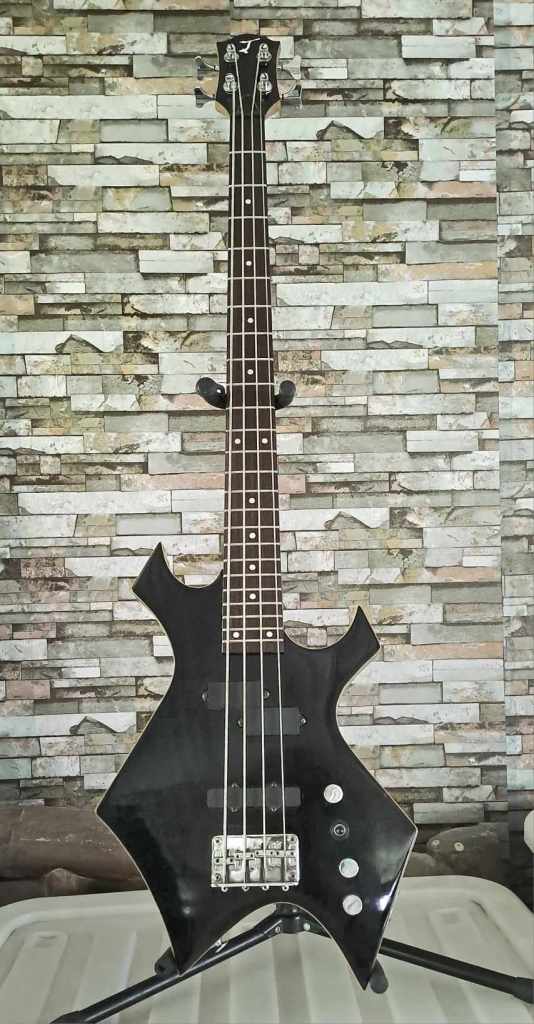The Warlock
The history of the legendary Warlock solid body electric guitar and bass guitar design dates back to 1969. B.C. Rich company founder Bernie Rico came up with the design but it wasn’t introduced until 1981, when the design was finally built when local guitarist Spencer Sercombe of Shark Island urged Rico to do so.
Being the only guitar Rico ever designed at the drafting table using straight-edges and French curves. With the guitars’ feature having that distinct jagged shape (and two humbucker pickups), with lots of curves going into straight lines, it seemed to him that it was the ugliest guitar he’d ever designed.
Nevertheless, the Warlock’s introduction paved the way for B.C. Rich’s rise to iconic status in heavy metal. And in conjunction with its far-out design and the emergence of hair metal culture of the late ‘70s and early ‘80s, this helped establish the brand’s name and place in the market, and since then it has long been associated with the heavy metal scene. [1]
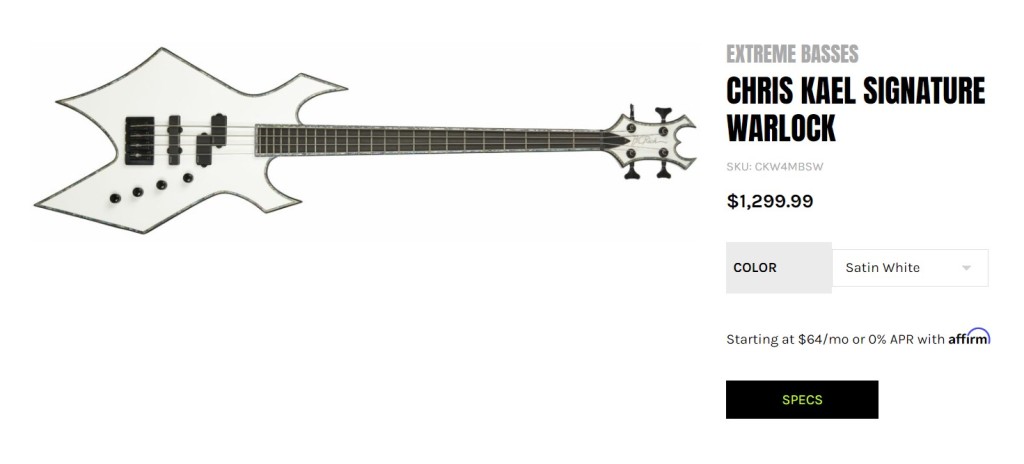
Generic
The American made B.C. Rich Warlock series not only carried this extreme and radical design but it is considered one of the most unique lines that the company has produced.
With its high build quality and craftsmanship, this popular pointy guitar design for the day did come at different price points but usually tended to lie on the pricier side.
Through the years, as a number, if not most guitar companies have outsourced their guitar manufacturing to several other countries, and purchasing the cheaper versions may not be without its imperfections. Many players did find the budget models as just aren’t up to par with the quality models. [2]
Sum of its parts
Whether it’s an electric bass or guitar most players enjoy the clear and full-bodied sound that solid-body guitars produce, their resonant properties and the balance between the tones.
So, does the type of wood for a bass body really matter?
Well, a bass guitar’s overall sound and tone may differ according to a number of factors – the brand, the type of body, neck, and fretboard material used, and the details in the construction.
Like different players have different style and preferences, the various types of wood or tonewoods also have their distinct character, density, and offer a broad range of tones and resonance.
Different types of woods (with different physical characteristics) resonate differently and their mixing (of body and neck-which may also affect a bass’ weight distribution and balance) typically results in certain tonal characteristic differences.
So as to what extent does the type of wood affect a bass guitar’s tone?
Well, the type of wood really affects the tone of a bass guitar, it does, but it may not be the single most important element in determining a bass guitar’s overall tone because when it comes to solid-bodied electric bass guitars, all other parts matters, like the type of strings, pickups, hardware and even the paint. [3]
Another reason is that although different types of (tone) wood have their own distinct features and character (density and hardness), it still bears little significance in the overall tone in solid-bodies because electronics, effects, and amplifiers also affect tone to a certain degree. [4]
The differences in tonal qualities of the different types of wood may not be readily evident unless you hear like a fox. And trying to determine how significant and noticeable the wood is might just be inconsequential on the whole. [5]
Generally speaking, for solid-body bass guitars the type of wood used including the body’s shape do play a role in the overall sound, specially in acoustic basses. [6] But considering all the variables, the wood just affects tone to a lesser degree because a bass’ final sound will always be the sum of all its components.
Roving
As one iconic design, we always thought of owning one Warlock bass guitar. And in the course of our Facebook marketplace search for bass guitars through the years, we first saw one up for sale on October 8, 2019 in Manila, selling for P7,135.00 including a leather gig bag.
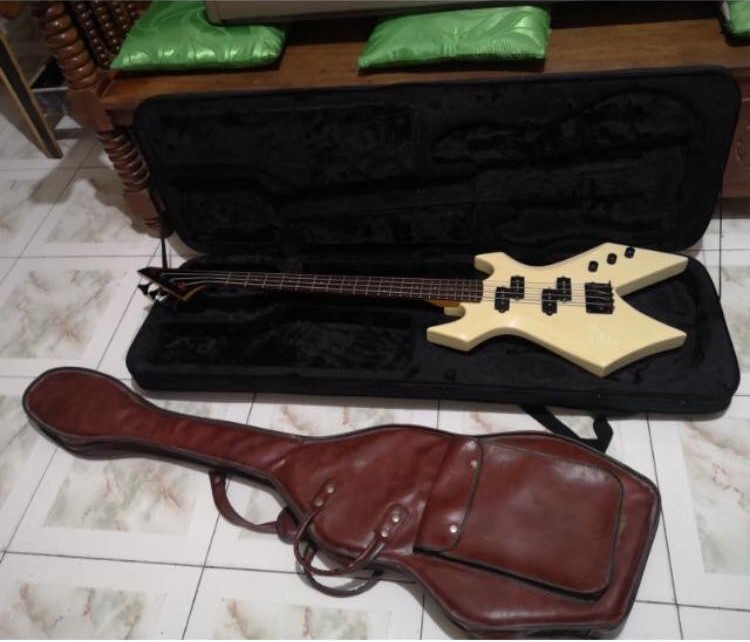
The second one we saw was a P13k from Tagum City on April 24, 2020. Our third brought us close to purchasing one, a fair-grade Fernandes Warlock bass from San Mateo, CALABARZON selling for P3.5k on July 28, 2020.
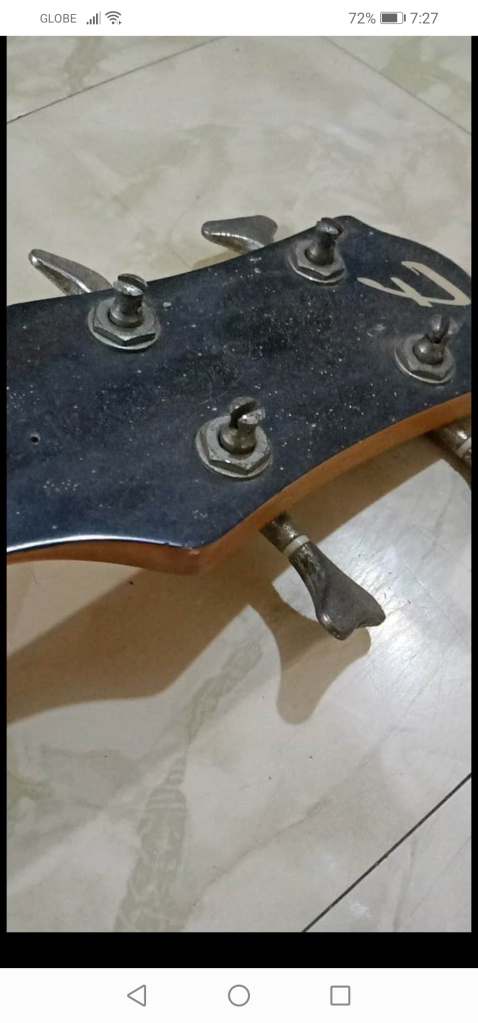
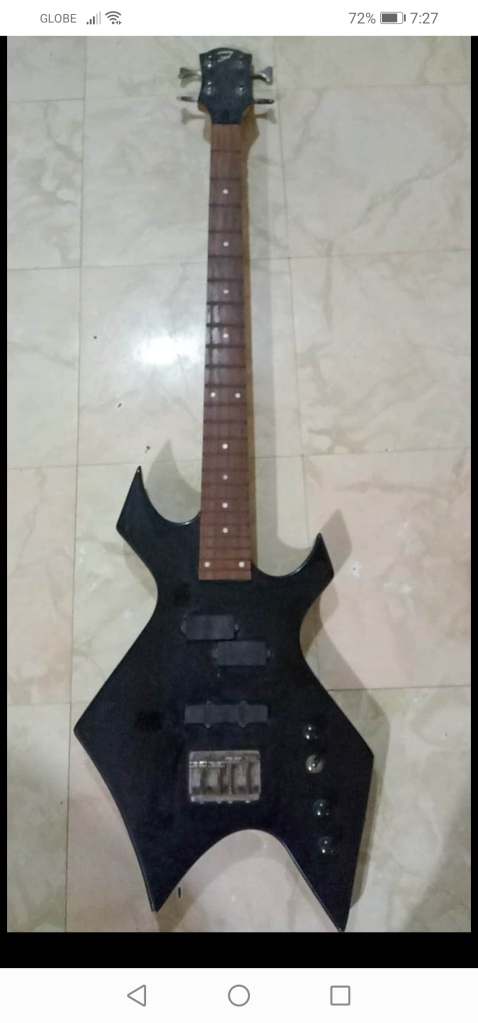
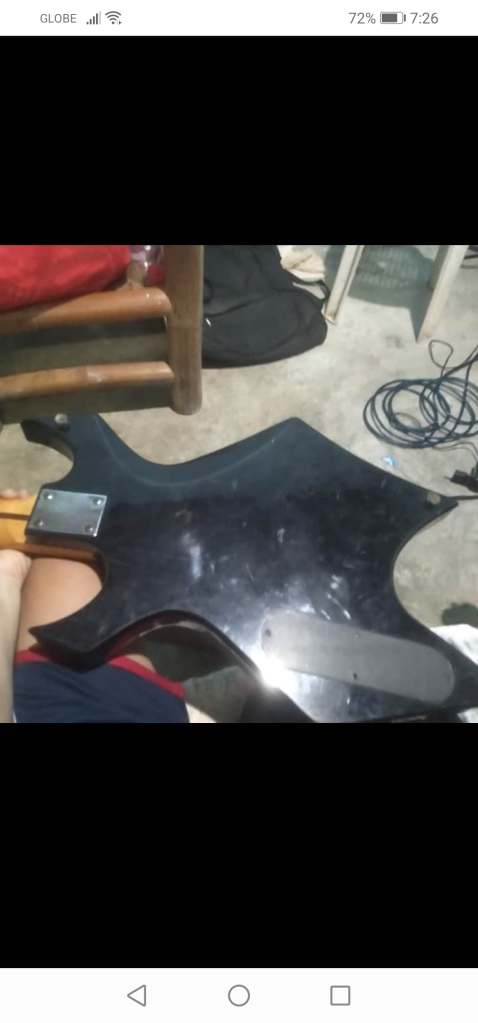
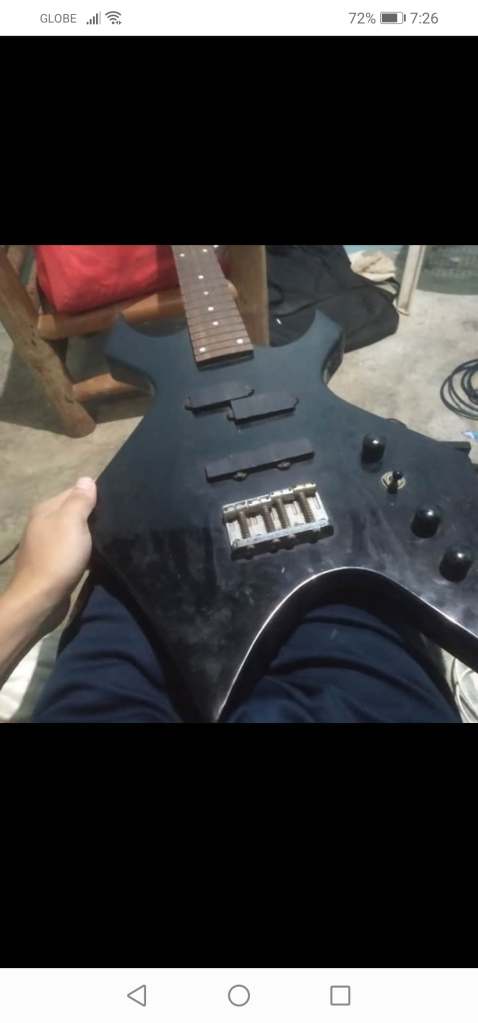
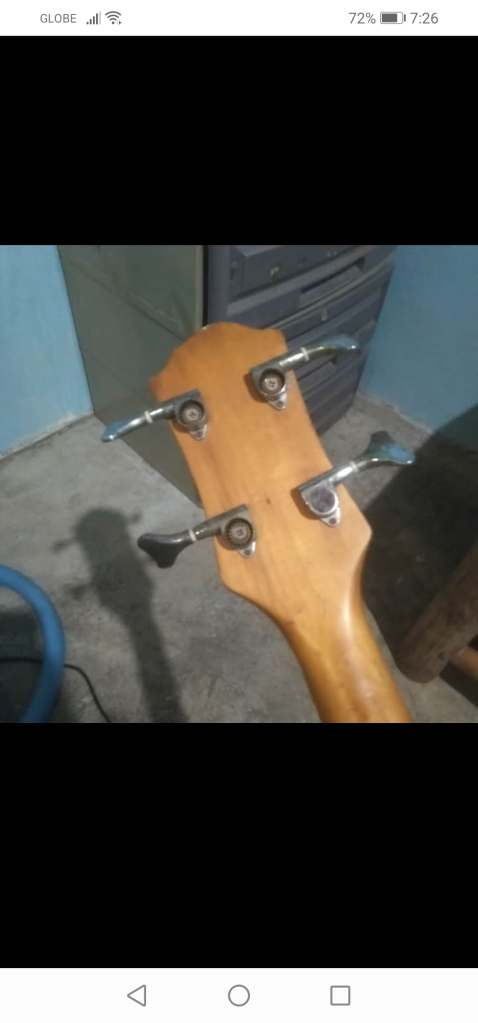

Our first encounter with an actual Warlock bass guitar was when we paid Iligan City’s Master Luthier, Sir Edgar Rabago of ER Custom Guitars, a visit on March 22, 2022. He had this MIJ mid 90s Fernandes Warlock bass guitar model with a reverse headstock.
Being able to touch and getting a feel of its weight and balance, we found the body a bit heavy, and although Warlocks are infamous for their neck dive, [7] this one had good balance and had no neck dive problems.

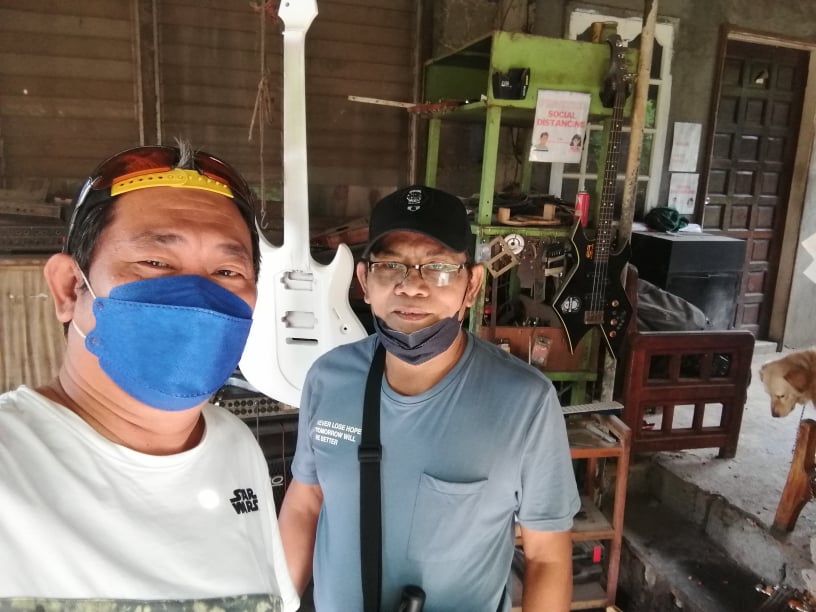
The fourth one we saw on sale was one from Minglanilla, Central Visayas on January 22, 2023 and selling for P11k. Then we saw the fifth on sale at Cagayan de Oro City on March 13, 2023 selling for P6k, which took some time before it got sold.
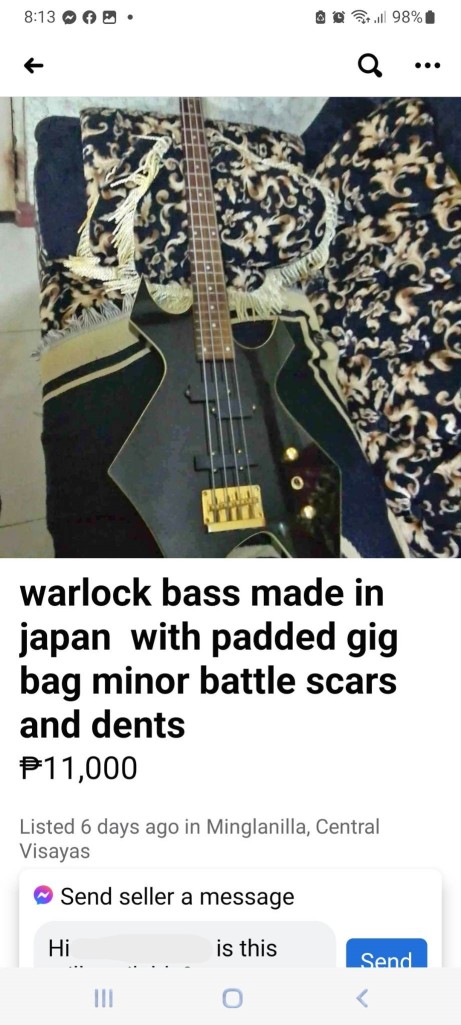

Then it was on the 14th of August when we saw another one inspired by the classic B.C. Rich Warlock design. This bass guitar was posted for sale from Tagoloan, and we got interested in purchasing this copy.
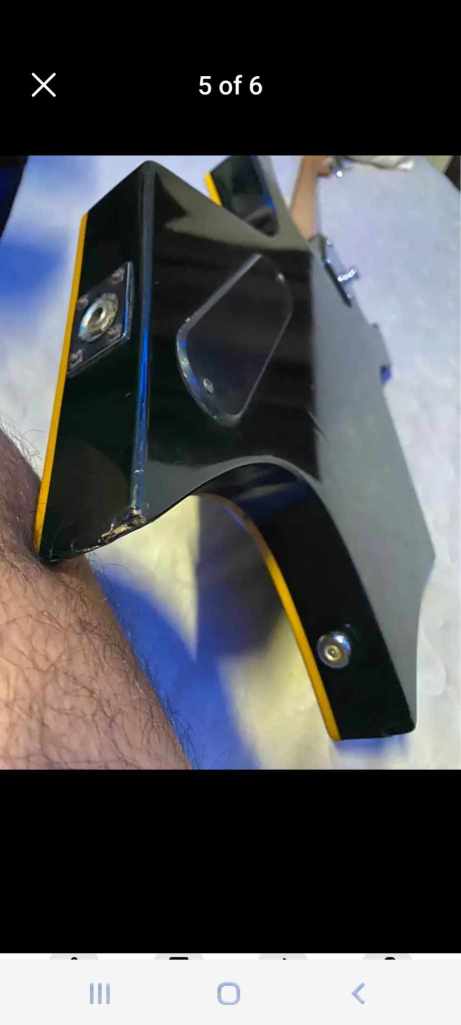
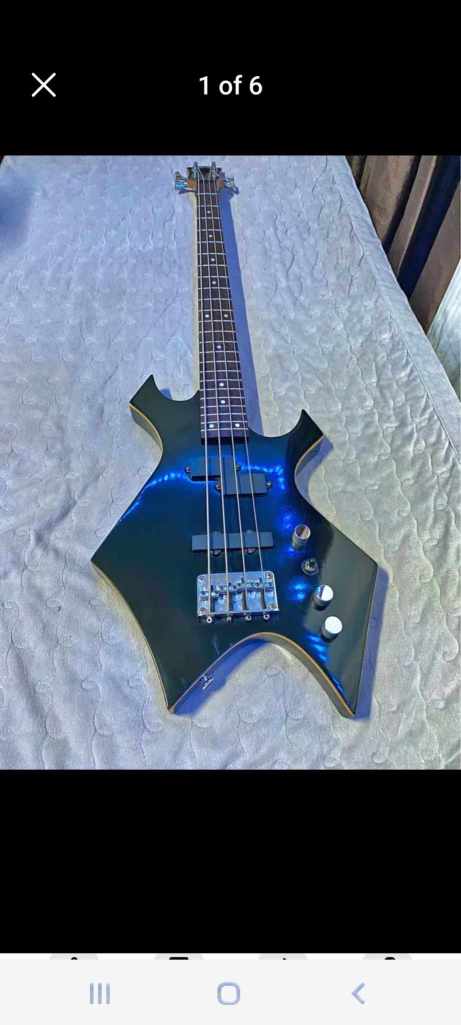
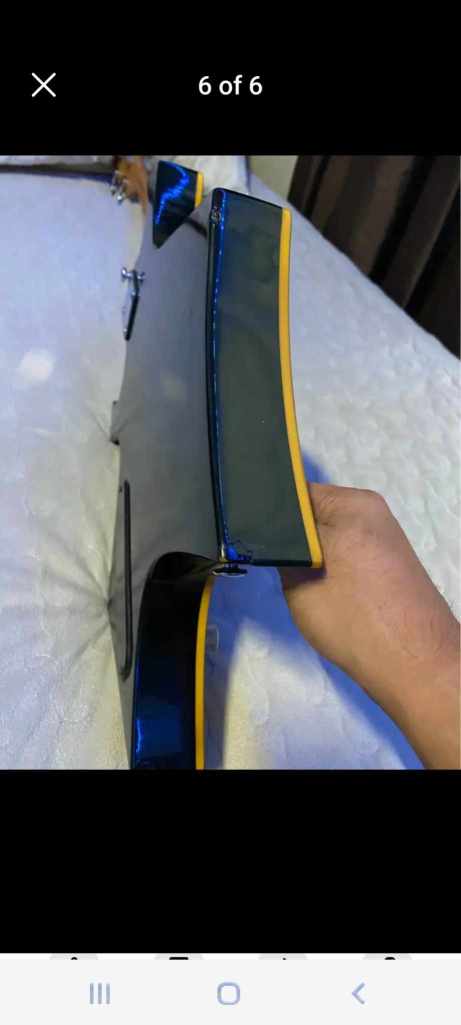


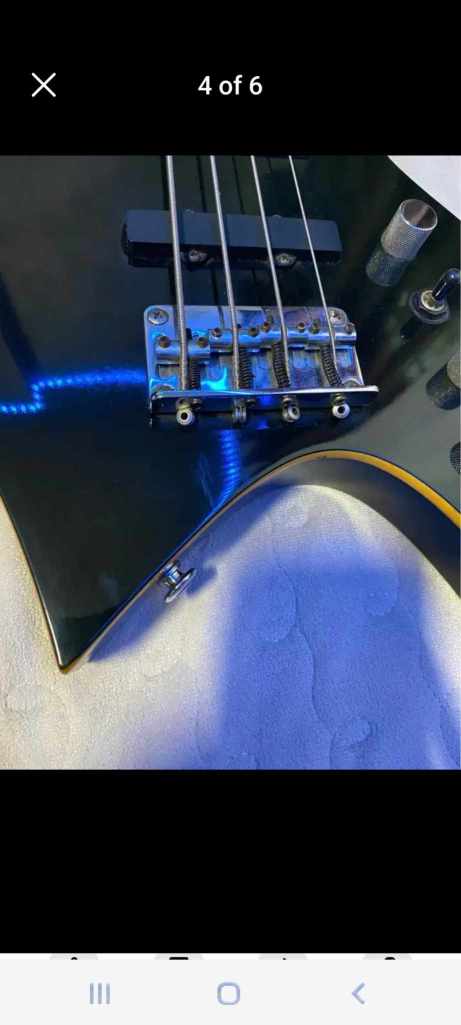
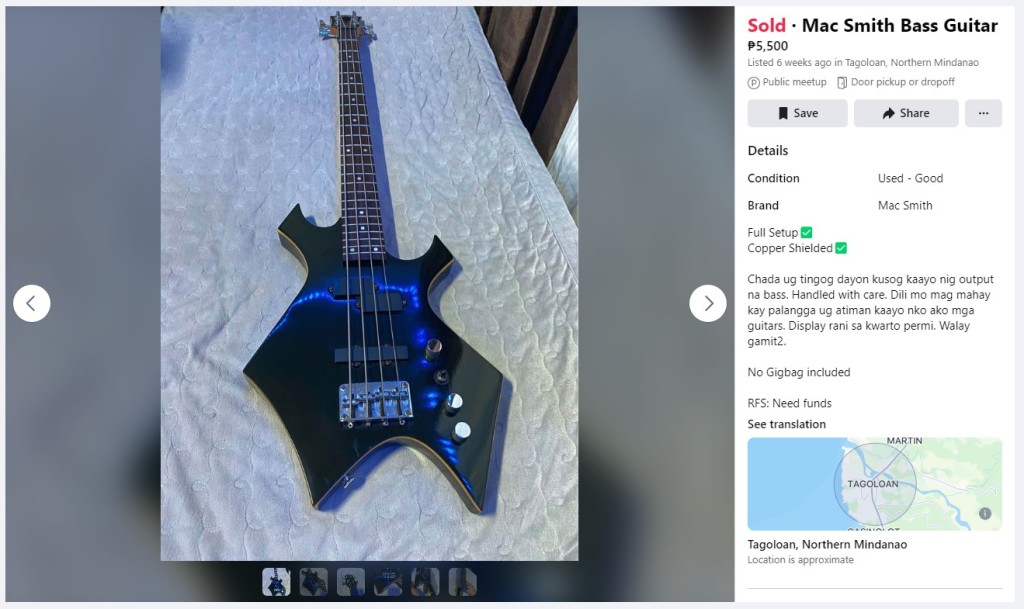
Type of Wood
We still haven’t heard of this brand before so we searched about it on the internet and found this thread online implying that it was probably made in China.
In one of the subsequent replies to the post, one user stated that “There’s something about the wood of the Macs that I don’t like…” [8] which made us think and ask: What type of wood must it be made out of?
Since we still have very little information about this brand and model, and finding another similar bass in another Ad was not of much help, as the info on the type of body wood was left-out in the description.
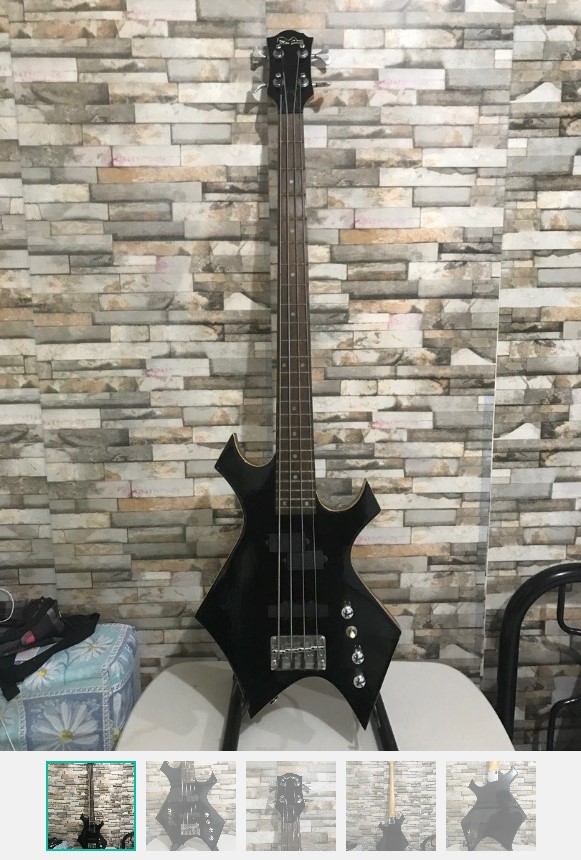

We just kept pondering, is it made out of cheap solid piece of wood? Soft tonewood? Engineered wood? Alternative modern materials?
Well, it just made us wonder what lies inside, as to the kind of tonewood or material used that lies under its body’s top coat, as we couldn’t see no natural wood grain lines or patterns, or the natural color of the wood because of its traditionally hued solid-color finish.
Anyway, the bass from Tagoloan was selling at a reasonable price and in very good condition, and since we were so interested in this classic design, we didn’t hesitate and wasted no time to buy it right away, to have it as a new addition to one’s collection.
Punctilious
Meeting up with the seller in person, Mr. Jerome Tagarao, four days after seeing the Ad, and paying careful attention to every detail, we closely inspected the bass. It’s a passive 24 fret, 34” long scale bass with a nut width of 42 mm.


Neck Relief: Sighting the neck (nut to bridge, bridge to nut) = had a little amount of forward bow, checking fretboard profile on both the bass and treble side of the neck, upbow and relief were equal on both sides and were up to the 9th fret (no warping), rest of the fretboard up to the 24th fret was straight. We can still adjust the truss rod and straighten the neck a bit.
Action: All strings action on the 12th fret visual estimated values = close to the accepted values, slightly ≥2.0 mm on the E and A strings, around 2.0 mm for the D and G strings. And except for the other three bridge saddles, we noticed that the low E string saddle was almost bottomed out.
Cosmetic wear: Bits of finish scuffs, tiny finish chips on the front side = upper horn edge and lower bout’s lower horn side’s edge near the Volume knob, light scratches behind the bridge, behind the low E string side. And on the back side = lower bout’s edge upper horn side, and the classic pointy guitars finish chips at the two lower bout edges, or shall we call them bottom horns, or the bottom indentations/cutaways sharp edges.
We also noticed two sets of tiny bumps or swelling streaks running across the back, i.e., running transversely on both the upper bout and lower bout of the back side. Although we found it a little odd we just dismissed it – these are just on the back.
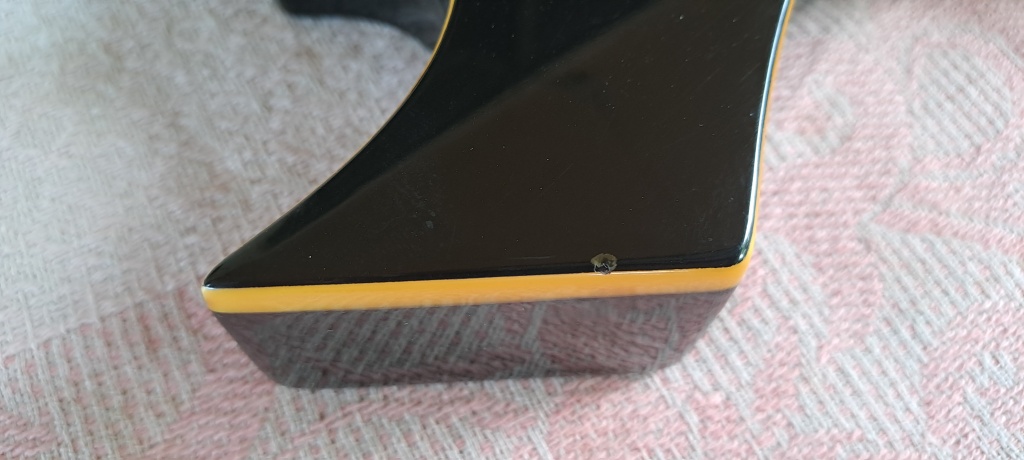
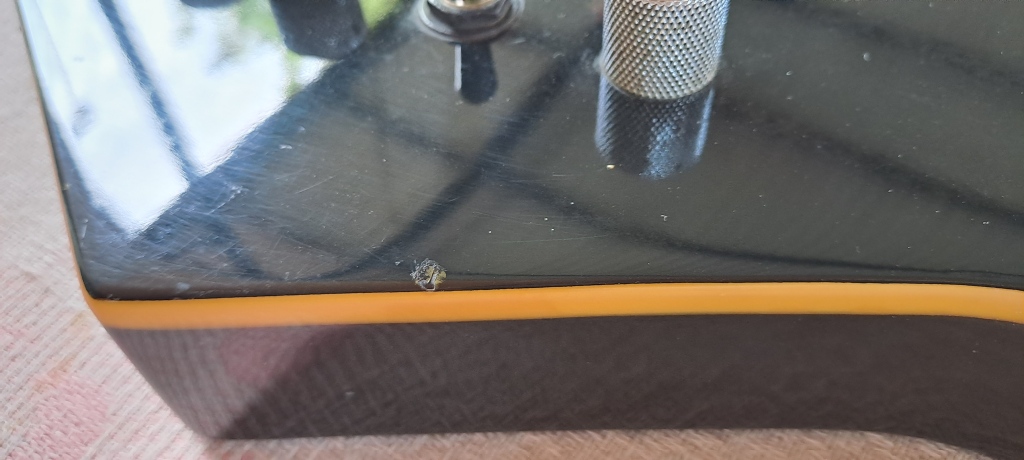
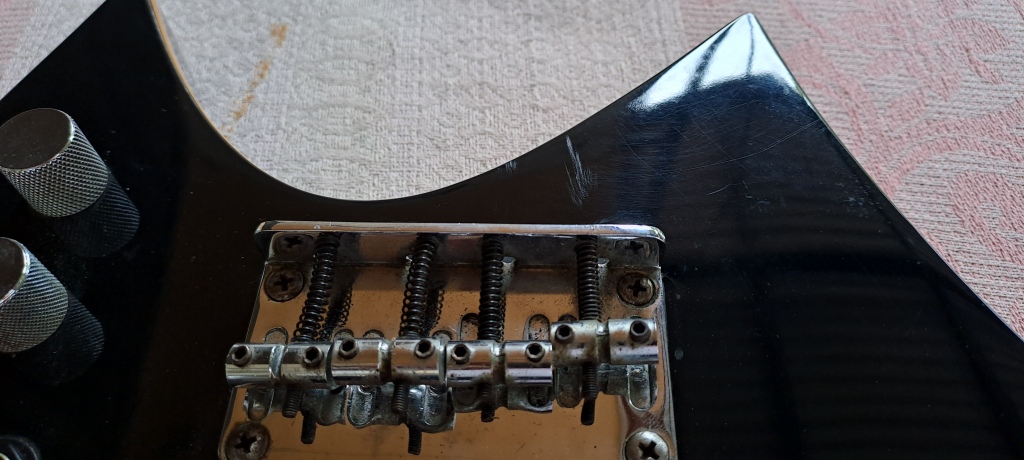

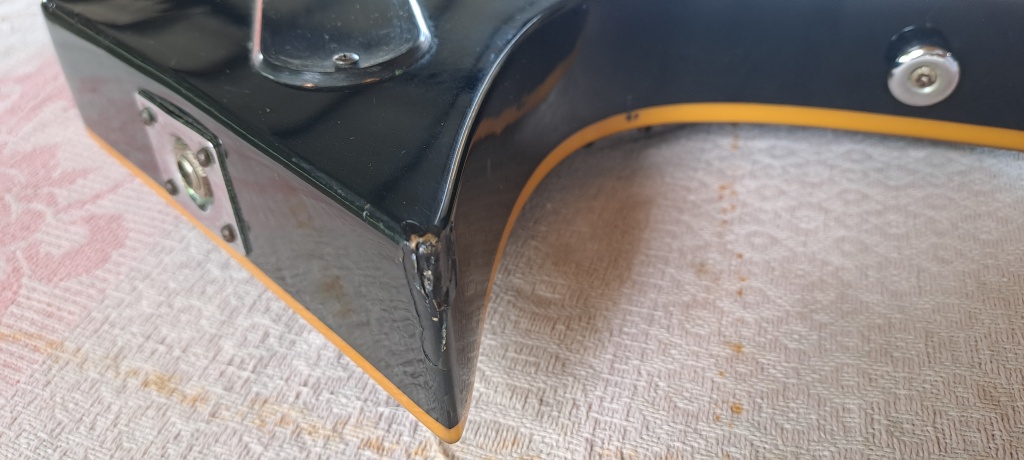
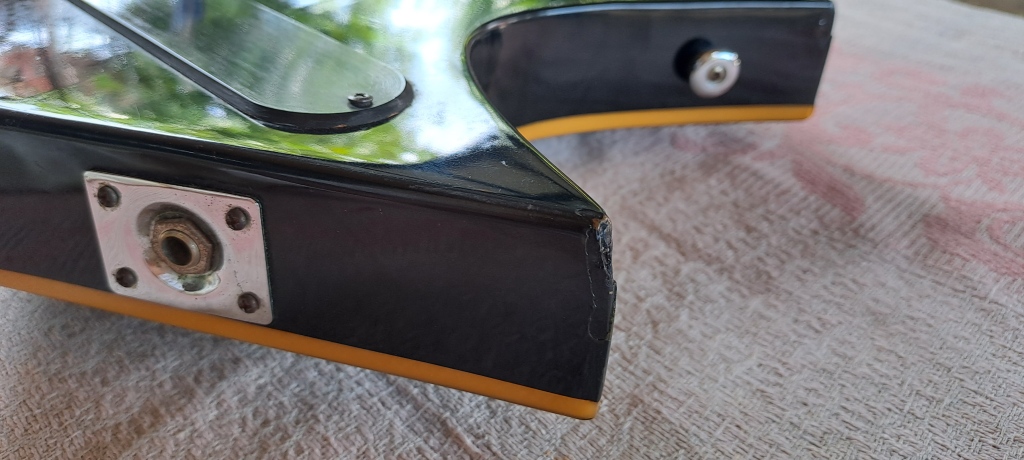
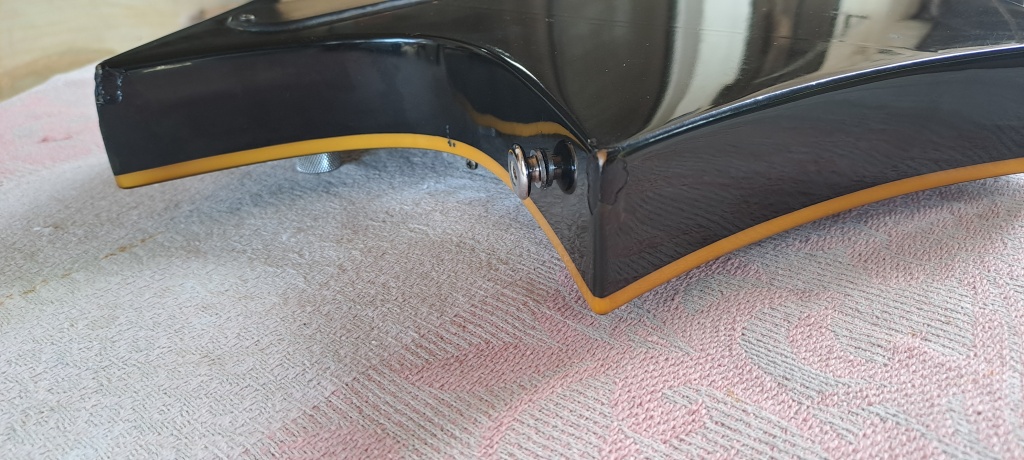
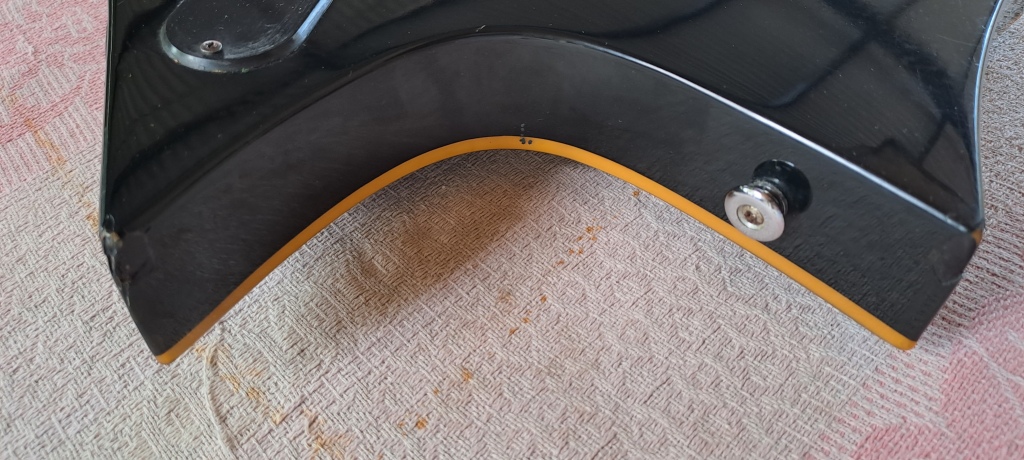

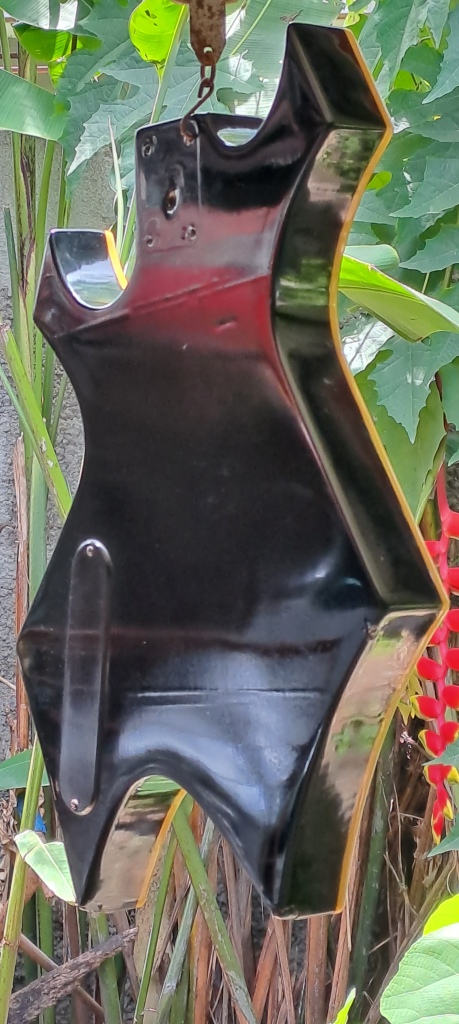

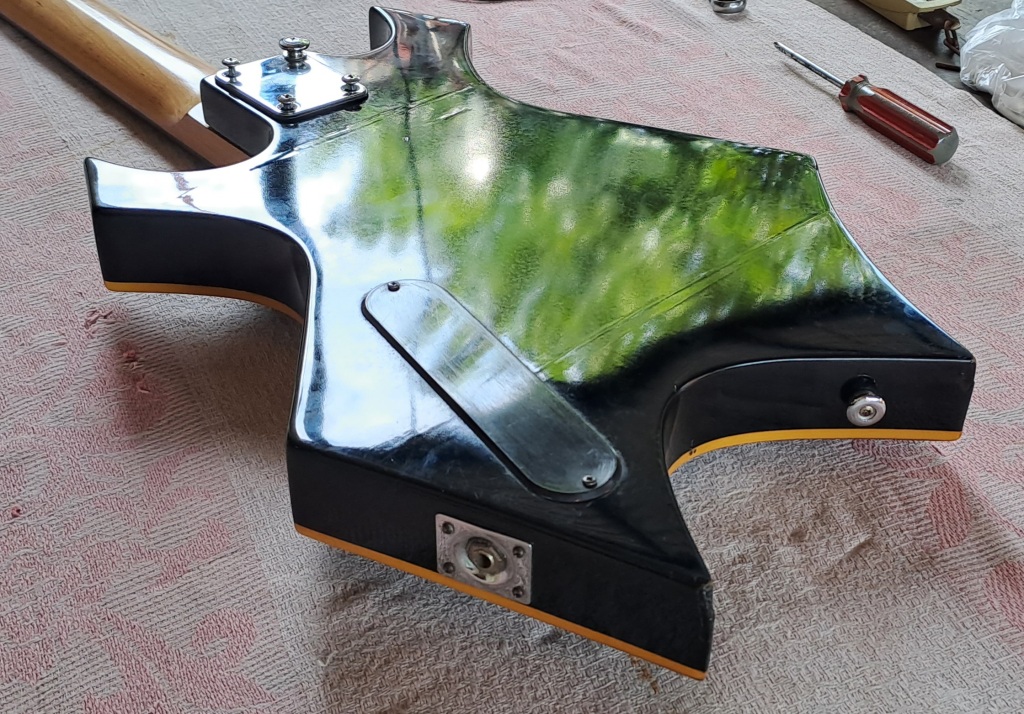
Time is of the essence, got some other place we should be with other tasks… so we purchased it.
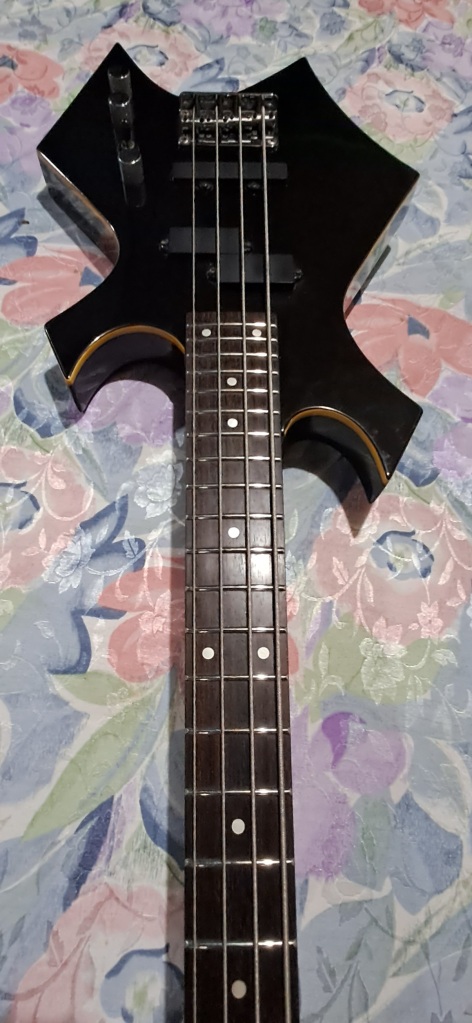




It’s what’s inside that counts
Aside from our plans on giving this bass a good setup, we initially had plans on adding a personalized touch to it by changing the headstock logo to one similar to the classic “R” logo using a custom headstock vinyl decal, to add that distinctive appeal and in honor of the company that created this unique design that revolutionized the 80s metal scene.
So after we purchased the bass and brought it home, we started working on it the following day.
First things first, we needed to find out what type of wood the body was so we removed the neck, and after it was removed, we were then able to see the material that the body was made of through the body’s neck pocket.
And we had our reveal (drumroll please)… the bass guitar’s body was made out of two pieces of ¾” thick 13-ply plywood that were bonded together.

Woah! Now we didn’t expect that. Have several basses in different types of tonewood but we never had one in plywood before. Astounding!
The last time we had a body, an electric guitar body made out of plywood was back in 1997. And now that we have a plywood bass, and one based on an iconic design, it just seemed like we struck gold (13-ply karat gold)!
This is indeed a beautiful addition to one’s collection!
Fresh setup
Mr. Tagarao informed us that the last time he setup the bass was three years ago. And now it was time to give it a fresh setup and do something about the low E string bridge saddle that was almost bottomed out.
So we adjusted the truss rod (turned clockwise) and lessened the neck relief some more, a little straight now, so we checked the action.
The low E string was now much closer to the 12th fret than it used to be, so we raised its bridge saddle, and now it was 0.8 mm from the bridge plate and we were able to fit a card between the bridge plate and the bottom of the low E string’s bridge saddle.
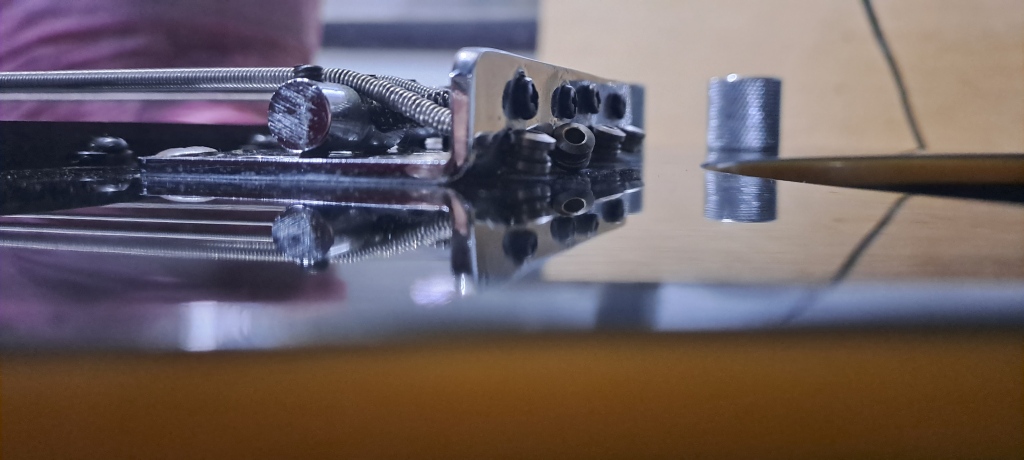
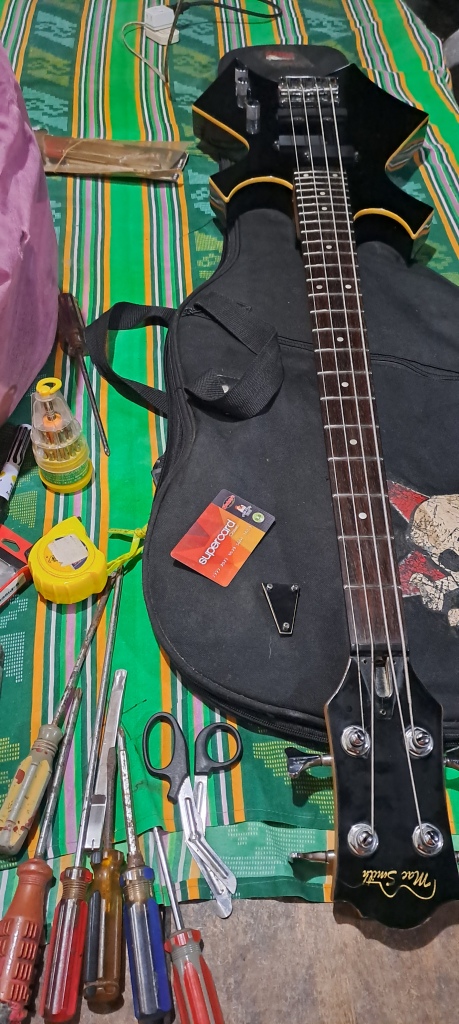
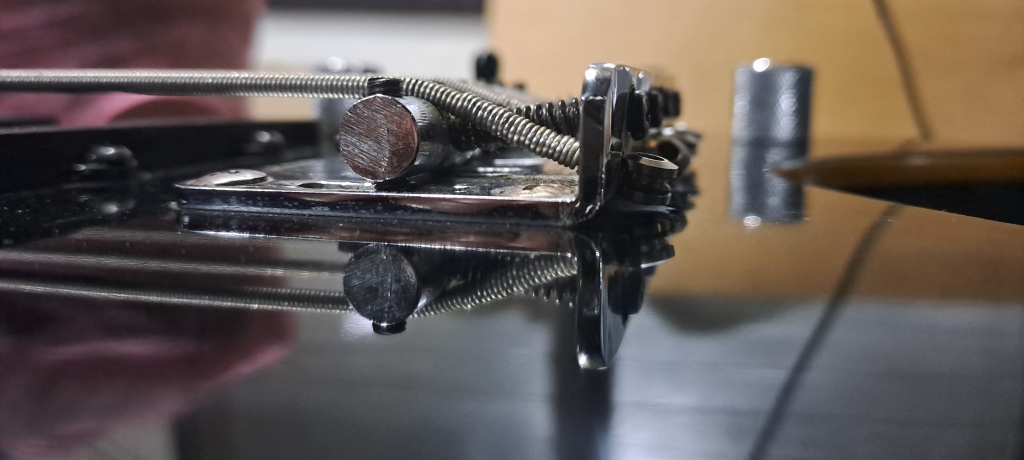
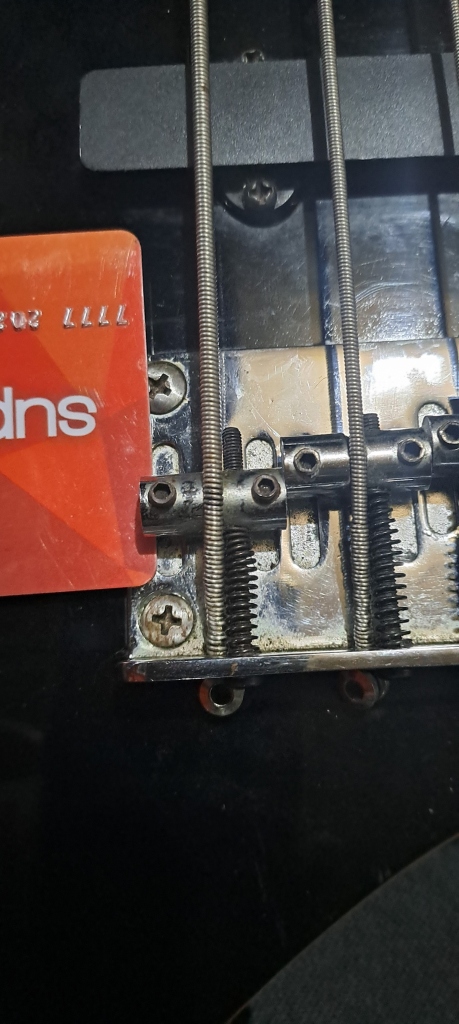
Illusion of Attention
After tuning the strings, we checked action by playing the bass, but the action for all strings was still high for us, so we thought of shimming the neck on the next day.
However, as we were playing the bass, and looking down the neck, when we were accessing the high register, we noticed something was missing.
Oh, man, the fret markers or side dots along the top edge of the fingerboard were all complete, but one of the fret markers on the face of the fingerboard was missing… the 17th fret inlay wasn’t there.
No way, are you kidding me?
Speaking about paying close attention to details, we simply didn’t expect it to be there, we believed we were seeing the whole picture.
But on missing this important detail, and actually ending up missing what was right in front of our eyes all that time, we just cannot help but laugh… 🤣 Illusion of Attention! [9]
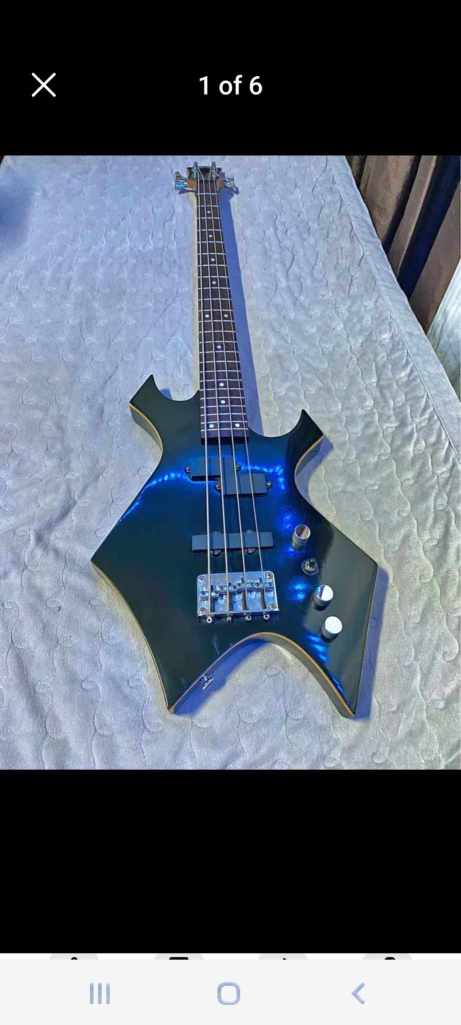
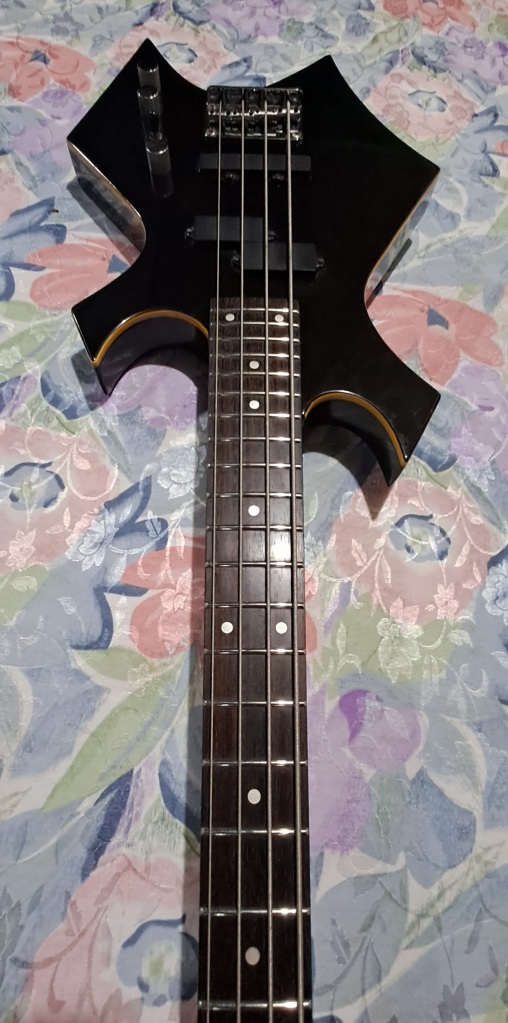
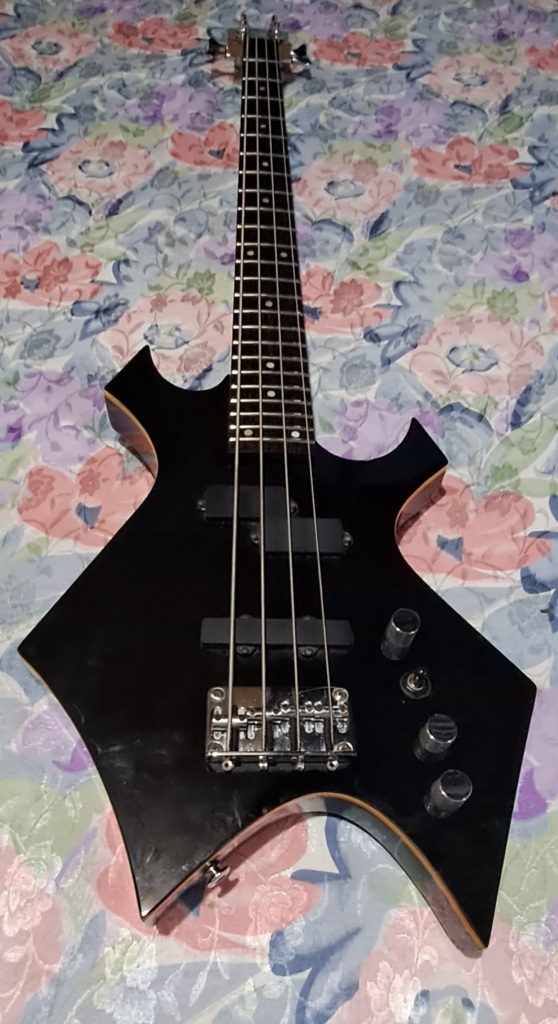
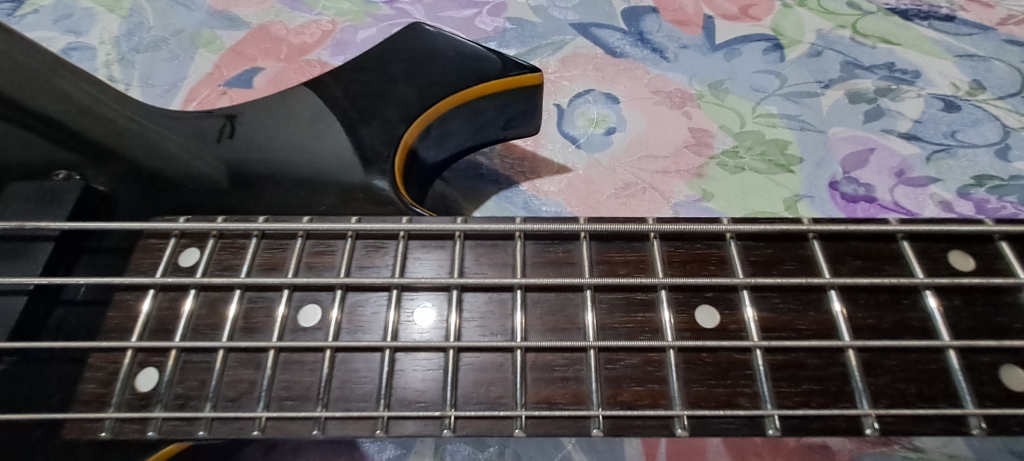
Shimming it!
We created a shim from a discarded plastic face shield and trimmed it to the right size, drilled two holes on it then placed it in the neck pocket. And then we proceeded to work on the missing fret marker.
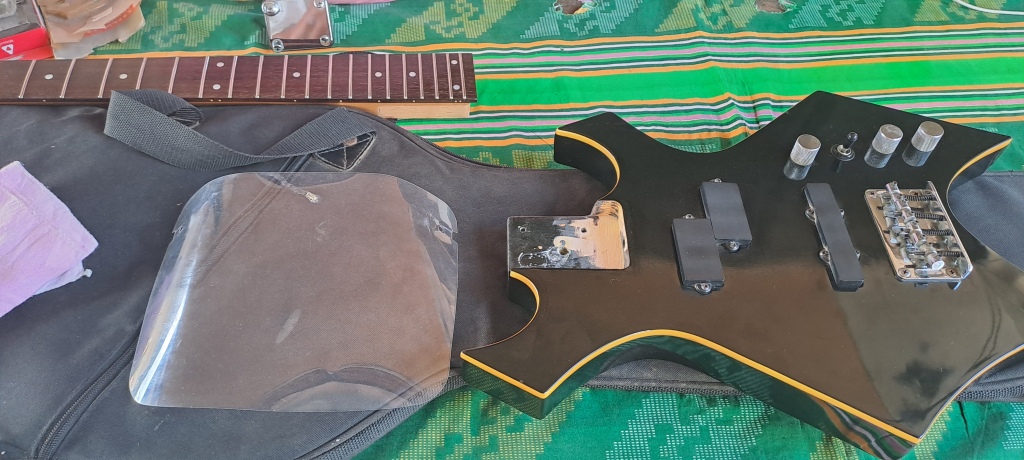
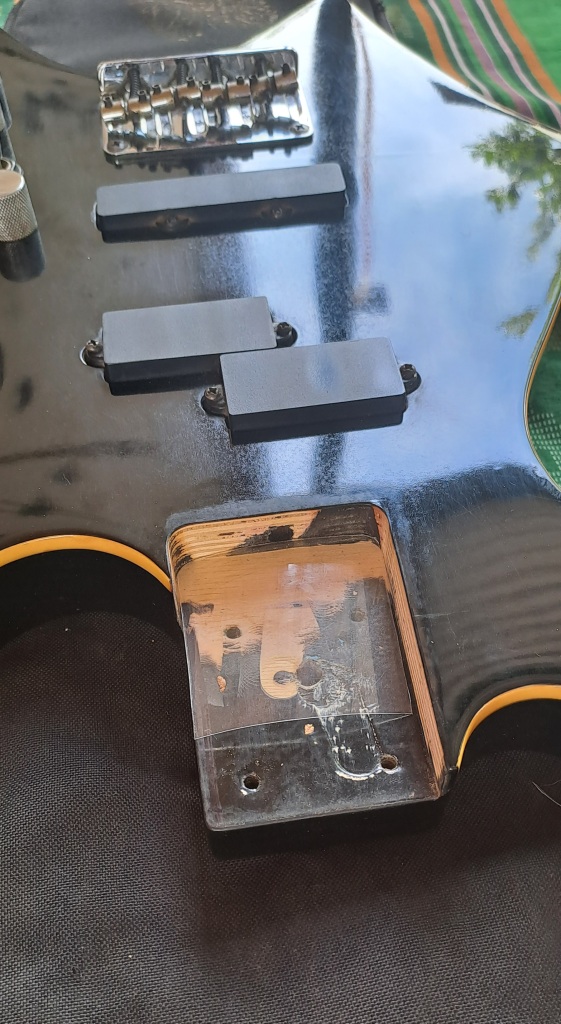
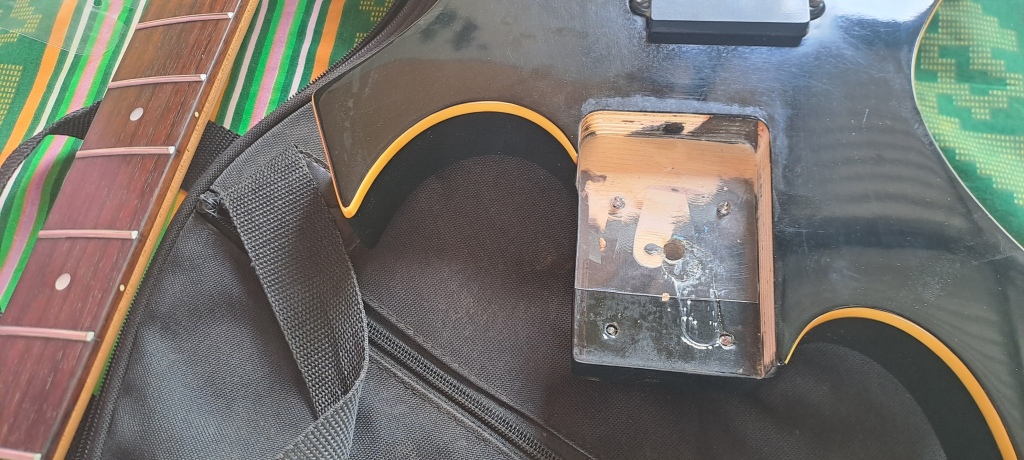
Well, it’s nothing a little fashioning can’t fix too. So we got to work on an alternative material we found and started whittling away until we reduced it to just about the exact size, then we drilled a hole on the face of the fretboard on the center of the 17th fret and installed it.
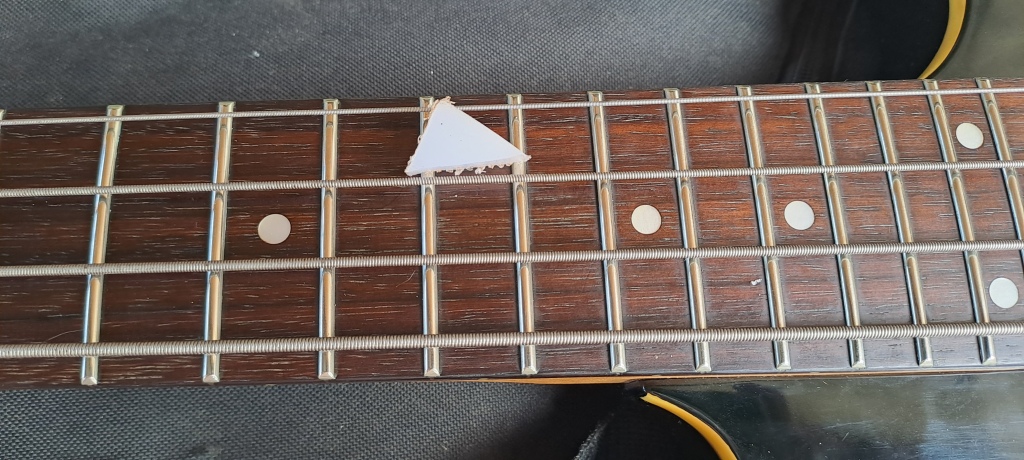
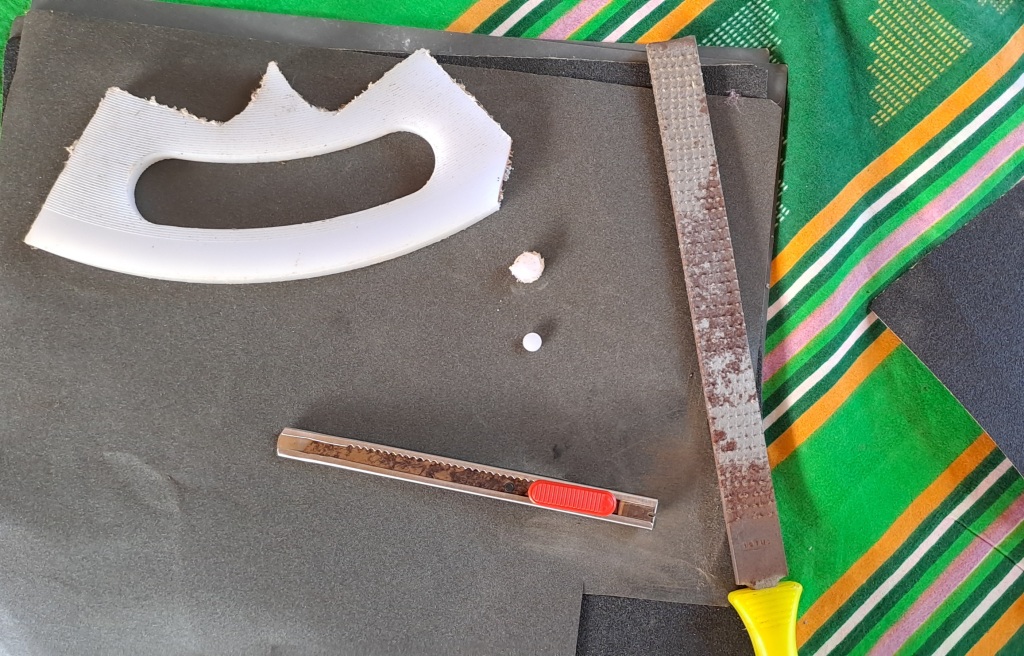
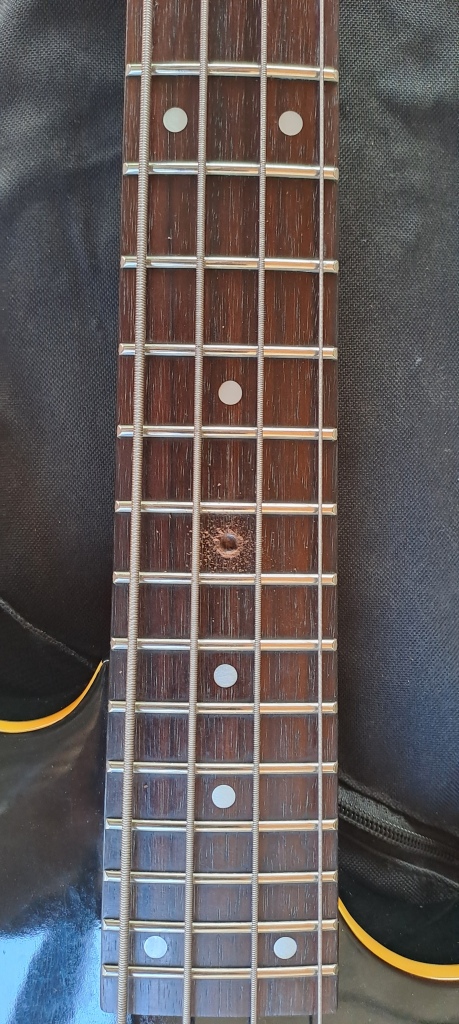
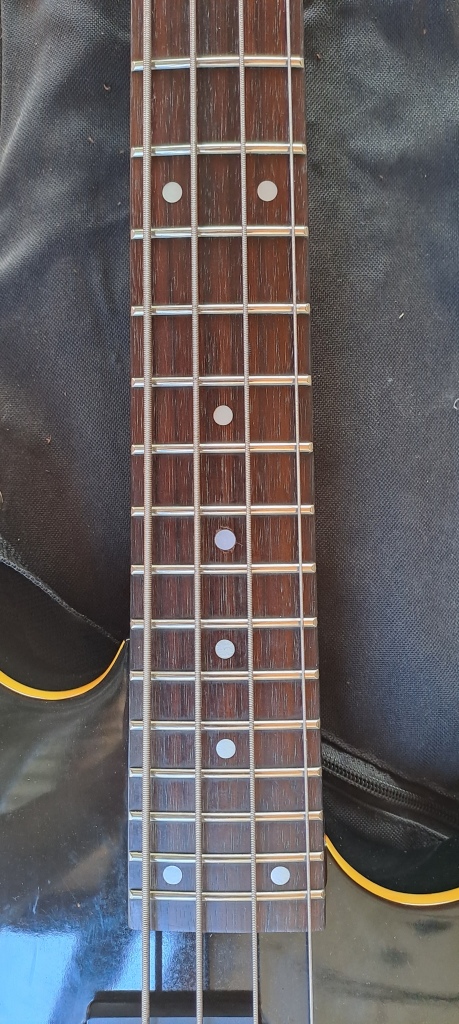
Two days later, we removed the neck and applied our custom headstock vinyl decal, applied a clear coat over it and left it out to dry.
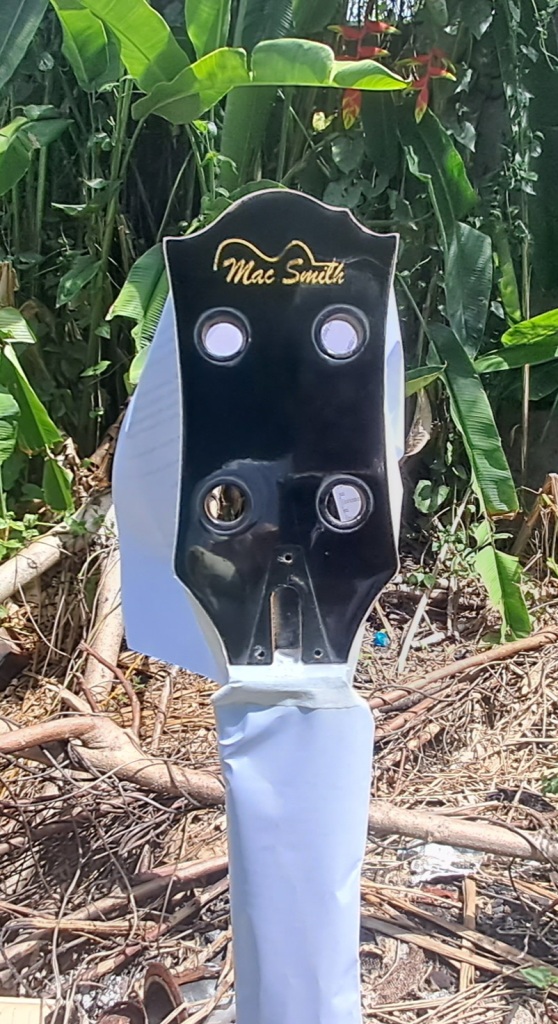
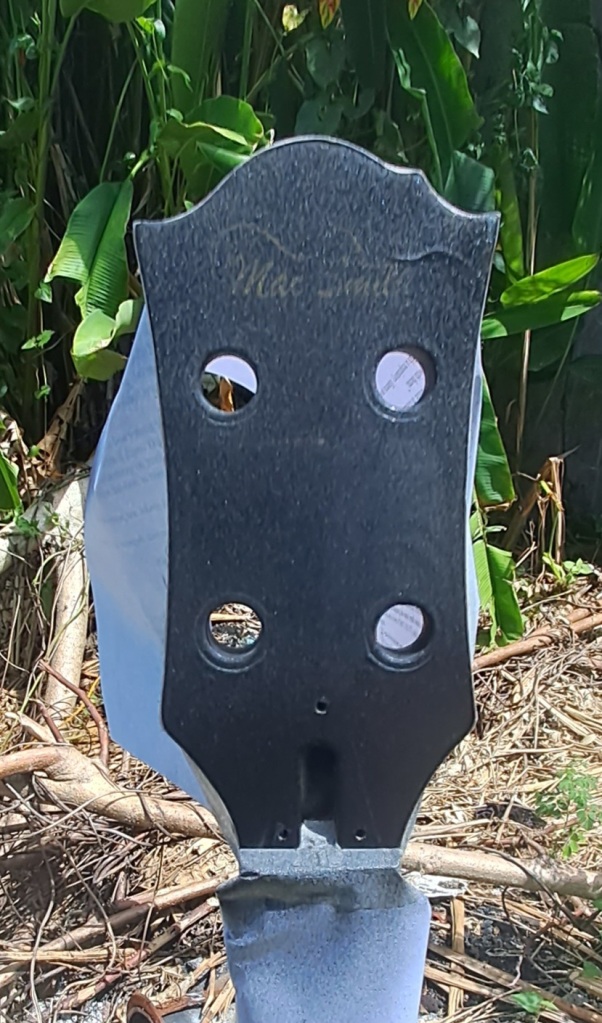


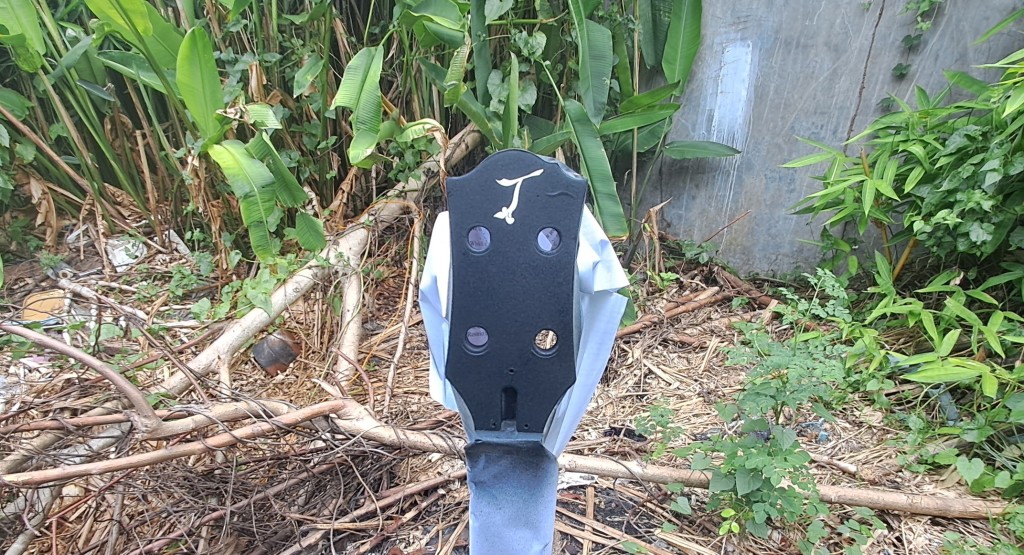
Really rings out!
After one month and six days, we finally reassembled the bass, replaced the strings, tuned it, tweaked with the bridge saddles heights, turned the truss rod, and adjusted the saddle heights again.
We then checked the action and neck relief employing the tap test for all the strings. Pressed on each string on the 1st fret and pressed on the 17th fret and tapped on the 9th fret (couldn’t reach the 8th fret as basses have longer necks than guitars), a bit of bounce in all of them, all is well.
Since we shimmed this so we checked intonation, however we didn’t need to adjust or move any of the bridge saddles, guess the shim made no big difference and had no tonal impact on the intonation, all was good.
Mr. Tagarao is also a guitar luthier and the adjustments he made on the bass’ bridge saddles for its intonation three years ago were just right.
So we then measured each string’s action on the 12th fret and came up with these figures:
E string = 1.8 mm
A string = 1.8 mm
D string = 1.5 mm
G string = 1.5 mm
Checking the bass again, all the strings had no rattles, and carefully checking each string on all the frets for string buzz, all was well… Zero buzz!
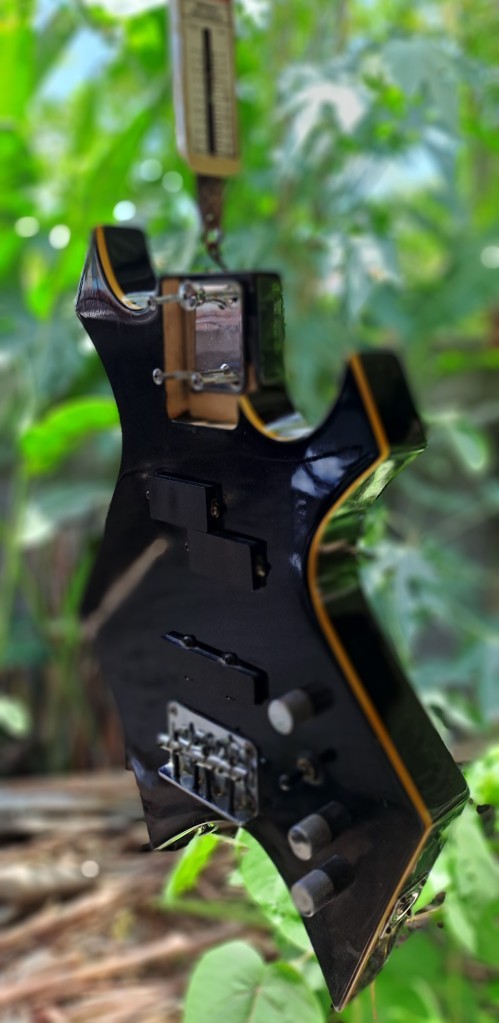
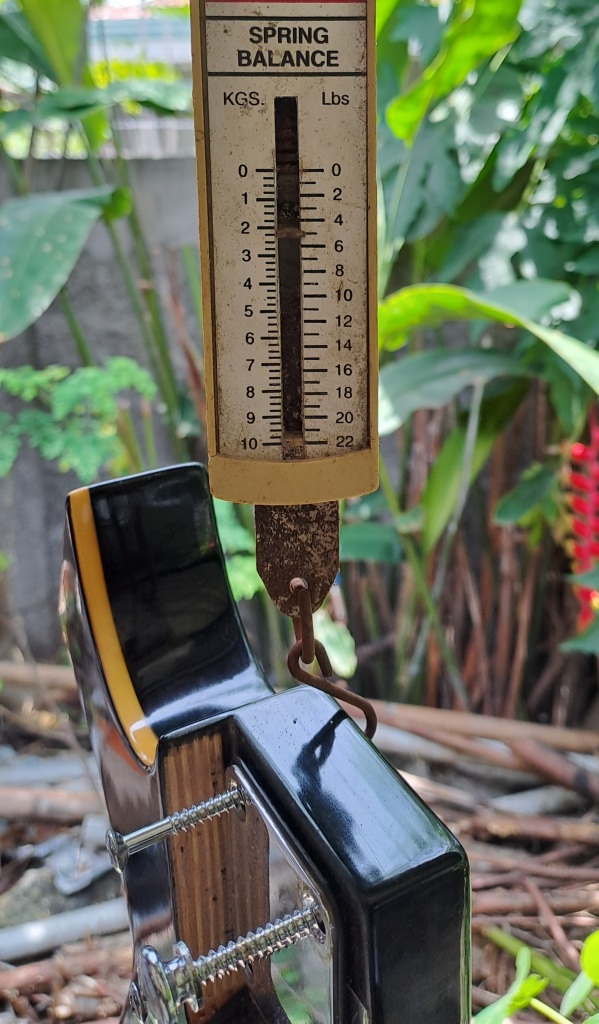
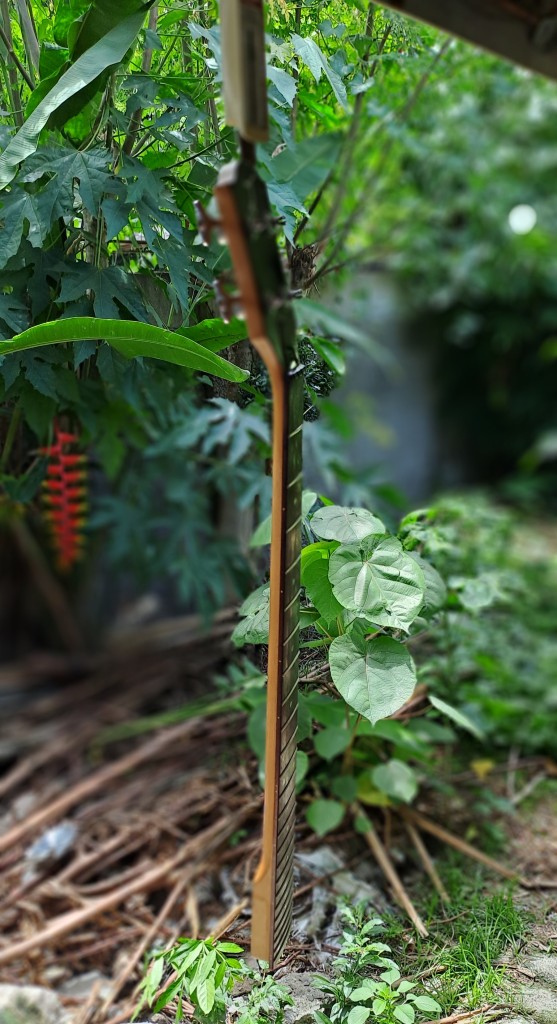
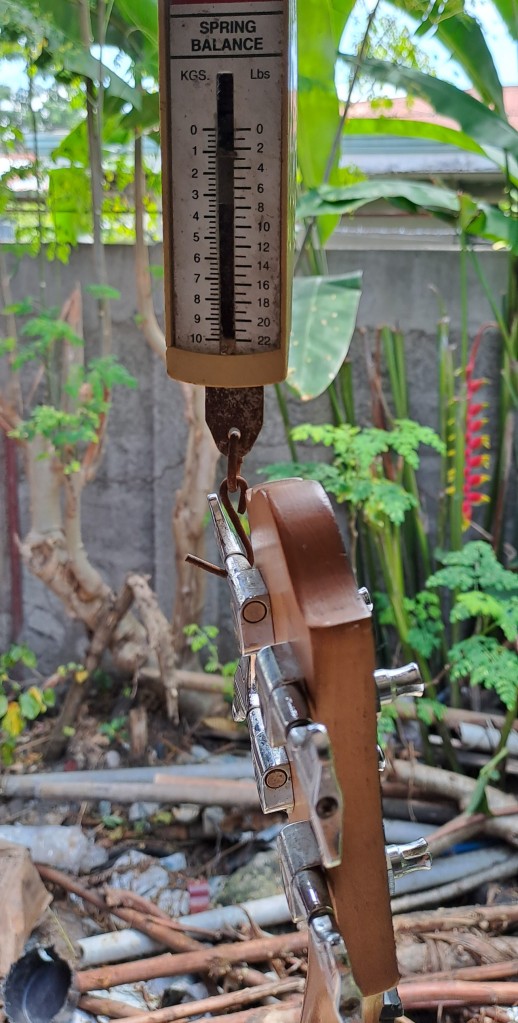
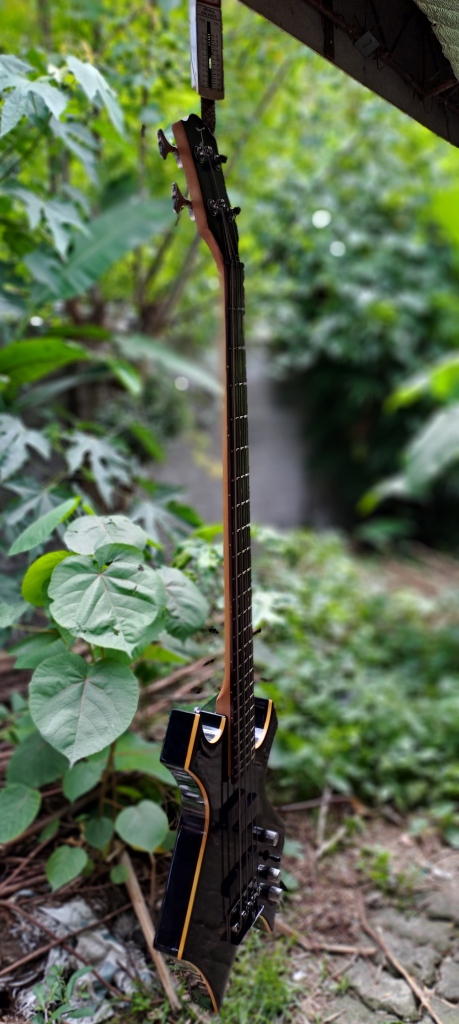

Plugged and played, well, we managed to achieve great playability for this 24 fret iconic bass guitar reproduction.
This bass was copper-shielded by Mr. Tagarao and yes, about its sound. Well, for a bass with a body made out of plywood, this bass has great tone and sustain, and we really liked this one!
This bass guitar really rings now!
B.C. Rich Warlock and other brands
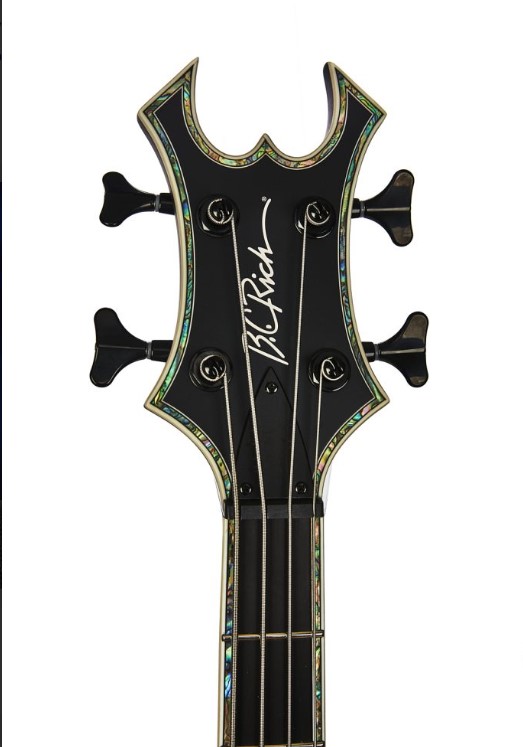

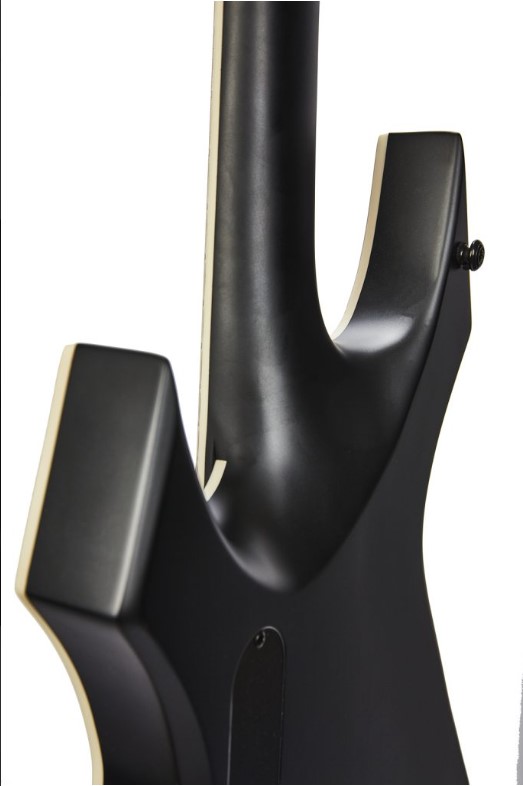
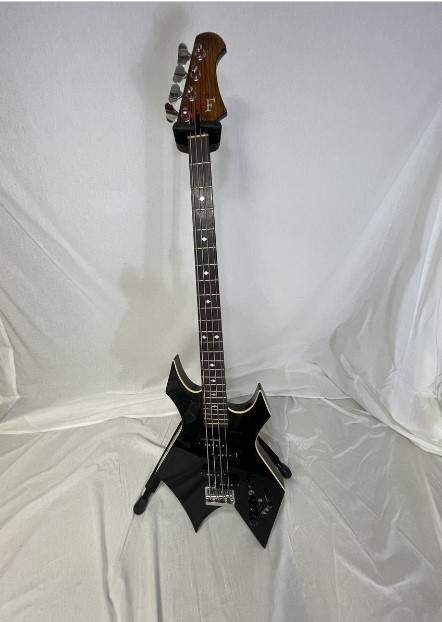
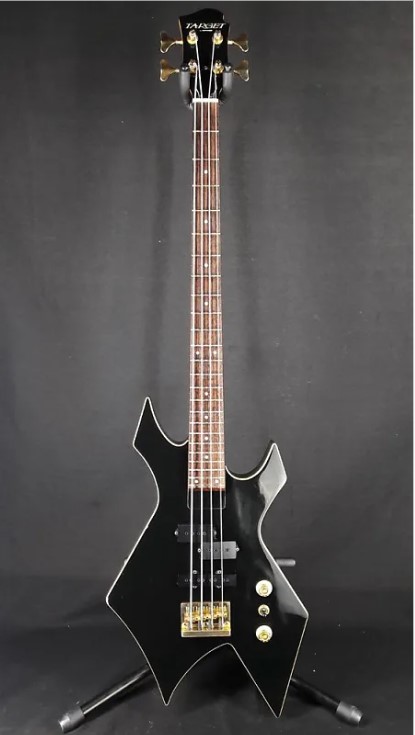
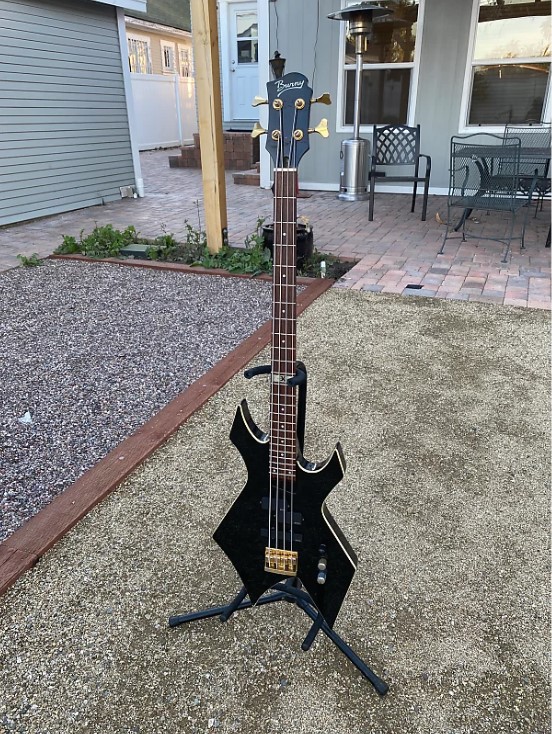

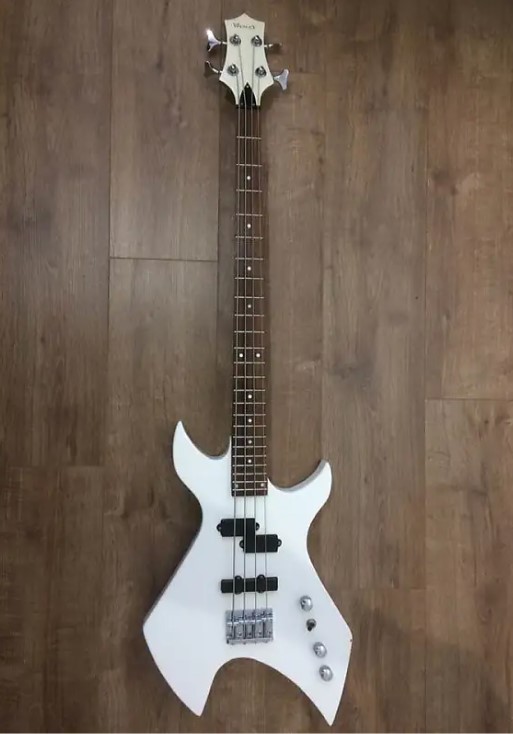
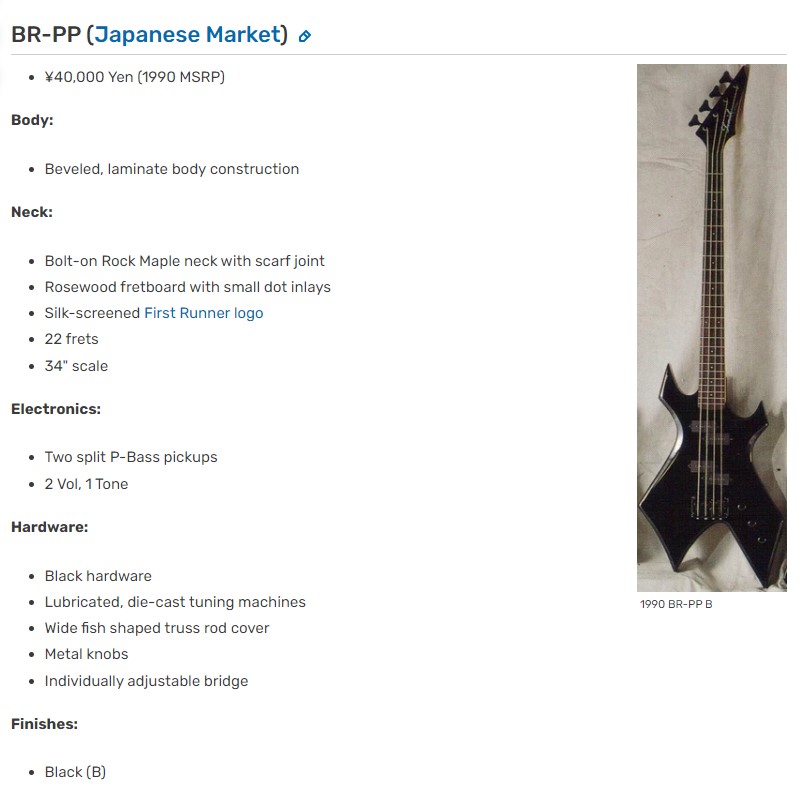
References
1. Wiki, C. T. M. (n.d.). B.C. Rich Warlock. Moviepedia Wiki. https: //moviepedia(dot)fandom(dot)com/wiki/B.C._Rich_Warlock
2. Jensen, S. (2023, September 8). BC Rich Warlock Review and Guide – Guitar Space. Guitar Space. https: //guitarspace(dot)org/electric-guitars/bc-rich-warlock-review/
3. Stringjoy. (2021). Guitar Wood types: A guide to the tonewoods used in guitar building. Stringjoy. https: //stringjoy(dot)com/guitar-wood-guide-tonewoods-guitar-building/
4. JohnnyFavorite. (2013, April 21). Secrets of Tone-Tapping wood. . . The Gear Page. Retrieved September 27, 2023, from https: //www(dot)thegearpage(dot)net/board/index.php?threads/secrets-of-tone-tapping-wood.1177959/page-2
5. Team, G. S. (2022, July 22). The anatomy of a guitar- terms you need to know – guitar space. Guitar Space. https: //guitarspace(dot)org/tips/the-anatomy-of-a-guitar-terms-you-need-to-know/
6. The parts of an electric bass guitar. (n.d.). https: //2kool4skool9dot)com/the-parts-of-an-electric-bass-guitar/
7. Gear, B. B., Gear, B. B., & Gear, B. B. (2014). Can you tell if a bass will have neck dive problems just by looking at it? eBass |. https: //www(dot)bestbassgear(dot)com/ebass/article/can-you-tell-if-a-bass-will-have-neck-dive-problems-just-by-looking-at-it.html
8. Mac Smith Guitars. (n.d.). http: //talk(dot)philmusic(dot)com/index.php?topic=93072.0
9. Cfp, D. G. (2017, September 26). How to avoid the illusion of attention (Which could cause you to lose lots of money). Rich as a King. https: //www(dot)richasaking(dot)com/illusion-of-attention/#:~:text=How%20could%20he%20surprise%20you,in%20front%20of%20their%20eyes.
Image Source (in order of appearance)
Chris Kael Signature Warlock – B.C. Rich. (n.d.). B.C. Rich. https: //bcrich(dot)com/product/chris-kael-signature-warlock/
Warlock Manila P7k (2019, October 8). Retrieved from Facebook Market Place.
Fernandes Warlock 3,500 (2020, July 28) San Mateo Calabarzon. Retrieved from Facebook Market Place.
Iligan City Master Luthier’s MIJ Fernandes Warlock Sir Edgar Rabago, Image ctto.
Warlock Minglanilla Cebu P11k (2023, January 22). Retrieved from Facebook Market Place.
Warlock CDO P6,000 (2023, March 13). Retrieved from Facebook Market Place.
Tagoloan Warlock (2023, August 14). Image Courtesy of Mr. Jerome Tagarao and retrieved from Facebook Market Place.
2,300 ONLY! Mac Smith Bass Guitar. (n.d.). Carousell. https: //www(dot)carousell(dot)ph/p/2-300-only-mac-smith-bass-guitar-1227261194/
With Mr. Jerome Tagarao/Warlock from Tagoloan. Image ctto.
